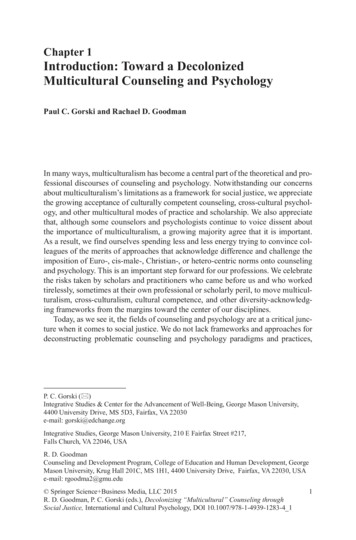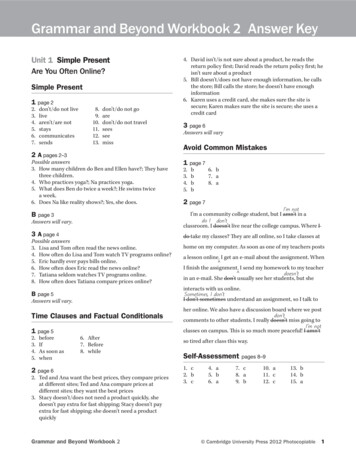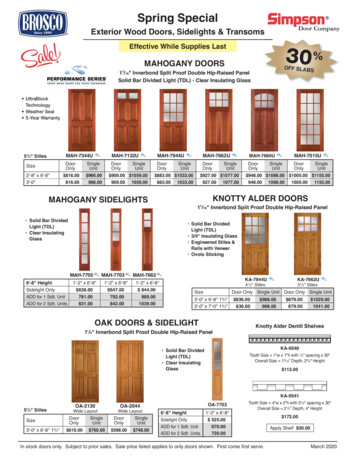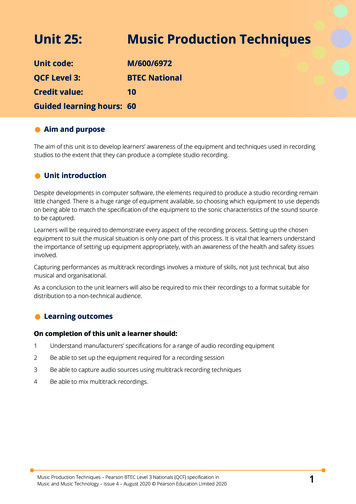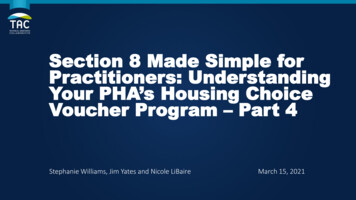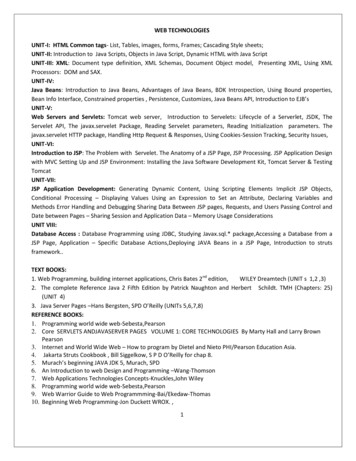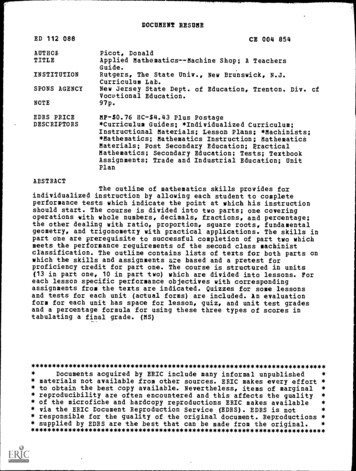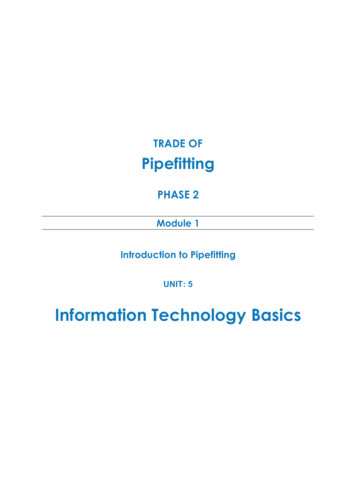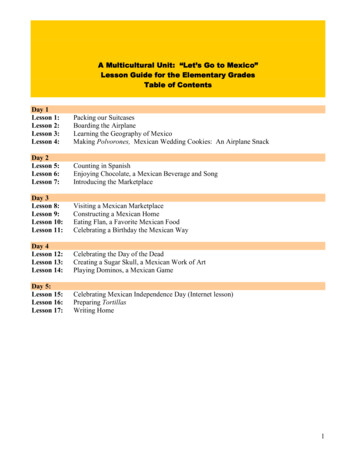
Transcription
A Multicultural Unit: “Let’s Go to Mexico”Lesson Guide for the Elementary GradesTable of ContentsDay 1Lesson 1:Lesson 2:Lesson 3:Lesson 4:Packing our SuitcasesBoarding the AirplaneLearning the Geography of MexicoMaking Polvorones, Mexican Wedding Cookies: An Airplane SnackDay 2Lesson 5:Lesson 6:Lesson 7:Counting in SpanishEnjoying Chocolate, a Mexican Beverage and SongIntroducing the MarketplaceDay 3Lesson 8:Lesson 9:Lesson 10:Lesson 11:Visiting a Mexican MarketplaceConstructing a Mexican HomeEating Flan, a Favorite Mexican FoodCelebrating a Birthday the Mexican WayDay 4Lesson 12:Lesson 13:Lesson 14:Celebrating the Day of the DeadCreating a Sugar Skull, a Mexican Work of ArtPlaying Dominos, a Mexican GameDay 5:Lesson 15:Lesson 16:Lesson 17:Celebrating Mexican Independence Day (Internet lesson)Preparing TortillasWriting Home1
Lesson 1:Packing our SuitcasesBrief Description:In preparation for their imaginary trip to Mexico, the students learn and practice the English and Spanishnames for common items of clothing. As part of this lesson, they cut out items of clothing fromcatalogues; label them in English and Spanish; and place them in a paper “suitcase” which they make totake on their “trip.”Objectives:1. Students will review, or learn, English vocabulary words for clothing.2. Students will learn, or review, the Spanish vocabulary words for clothing.3. Students will practice their handwriting using English and Spanish words.4. Students will learn to follow directions in English for making a project.5. Students will practice their small motor skills through cutting and pasting.6. Students will understand the concept of taking a trip.7. Students will practice their new vocabulary words by working together.Materials: Poster Board/Marker Flashcards with clothing labeled in English and Spanish; 1 set for the class Clothing catalogues Scissors Handout with pictures of clothing labeled in Spanish; 1 per student Small file cards Glue Pencils Light colored construction paper containing the outline of a suitcase, including four holes prepunched for handles; 1 sheet per student Crayons File folder; 1 per student YarnKWL Chart:The teacher leads the students in making a KWL chart on a piece of poster board entitled “Clothes WeWill Take to Mexico” and divided into sections for boys clothes and girls clothes in Spanish and inEnglish. The students volunteer the names of items in either, or both languages, that they will take onthe trip; and the teacher records them in the proper sections. When there are an appropriate number ofitems on the lists, the teacher proceeds with the lesson.Procedure: The teacher shows the students the flashcards of clothing; reviews the English name for eachitem and introduces the Spanish name for each item. Primary students cut out at least six items of clothing from catalogues, paste them on small filecards and label them with the English and Spanish names; they may use the clothing handouts asreference.2
Depending on their skills, intermediate students can cut out and label at least ten items ofclothing in English and Spanish.Working in pairs, the students use their file cards as flash cards and say the names of the clothingin English and Spanish.The students cut out the suitcase; color it with their crayons; paste it on the file folder; trim thefile folder to fit the pattern; fold the suitcase in half; and thread the yarn through the holes.The students put their file cards with their labeled items of clothing in their suitcases.Homework: Primary students take their “suitcases” home; use their flashcards for practicing their vocabularyin English and Spanish; and review their handout. Intermediate students write six sentences about the clothes they will take on their trip to Mexico.In three sentences they name the clothes in English; in three other sentences, they name theclothes in Spanish.Assessment: The teacher calls out the names of items of clothing in English and in Spanish and primarystudents who have that item hold up their flashcards. The teacher keeps track of the students’participation and whether they hold up the correct card. The teacher holds up her flashcards and directs students to write the name of the clothing item inEnglish or in Spanish.Adaptations for ELL Students: Activity based learning is used to introduce new words. Using Spanish and English helps introduce English vocabulary to Spanish speaking students. Introducing Spanish vocabulary allows ELL students to participate more fully in class. Cooperative learning provides extra support.Direct Learner Strategies: Memory- Students create mental images; apply images and sounds; review well and employaction through an activity based project and flashcard review. Cognitive- Students practice; send and receive messages; analyze and reason, includingtranslating. Compensation- Students use linguistic and other clues to learn vocabulary and seek help fromcooperative learning partners.Indirect Learner Strategies: Metacognitive- Students center their learning by paying attention; linking learning to alreadyknown material; finding out about language learning; and seeking practice. Affective- Students lower their anxiety by participating in cooperative learning. Social Strategies- Students ask for clarification; cooperate with peers; and develop a bettercultural understanding as they learn to use each other’s language.Multiple Intelligence Strategies: Linguistic- The teacher introduces new vocabulary; the students understand its meaning andrespond orally and in writing. Visual/spatial- The teacher uses magazine pictures and flashcards to introduce vocabulary;students respond by making their own flashcards. Intrapersonal- The teacher provides an opportunity for self-teaching; students learn through theuse of self-made materials.3
Interpersonal- The teacher encourages group work; the students participate in cooperativelearning.Standards Goal 1: To use English to communicate in social settingsStandard 1: Students will use English to participate in social interactions.Standard 2: Students will interact in, through, and with spoken and writtenEnglish for personal expression and enjoyment.Standard 3: Students will use learning strategies to extend their communicativecompetence. Goal 2: To use English to achieve academically in all content areasStandard 1: Students will use English to interact in the classroom.Standard 2: Students will use English to obtain, process, construct, and providesubject matter information in spoken and written form.Standard 3: Students will use appropriate learning strategies to construct and apply academicknowledge. Goal 3: To use English in socially and culturally appropriate waysStandard 1: Students will use the appropriate language variety, register, and genre.Standard 2: Students will use nonverbal communication appropriate to anaudience, purpose, and setting.Standard 3: Students will use appropriate learning strategies to extend theirsociolinguistic and sociocultural competence.References:Irving, Nicole & Griffin, Andy. The Usborne First Thousand Words in Spanish, rev. ed. Tulsa,Oklahoma: EDC Publishing, 1997.Strei, Lynita. Countries and Cultures for Young Explorers: Mexico. Grand Rapids, Michigan:McGraw-Hill Children’s Publishing, 2000.4
Lesson 2Boarding the AirplaneBrief Description:Departing for Mexico begins with having each students make an English-Spanish dictionary to takealong on their journey. The students will arrange their desks in rows to resemble an airplane. Eachstudent will color a boarding pass.Objectives:1. Students will brainstorm phrases one should know when traveling to a foreign country.2. Students will list these phrases.3. Students will look up Spanish spelling and pronunciation of each phrasenamed.4. Students will assemble and review a copy of an English-Spanish Dictionary.5. Students will arrange desks in rows.6. Students will color boarding pass.Materials: Poster Board/Marker Traveler’s Dictionary Dictionary Cards Scissors Stapler Student desks Boarding passes Colored pencils, markersKWL Chart:The teacher leads the students in making a KWL chart, using a flip chart entitled English-SpanishDictionary. The poster board is labeled:What phrases we know about traveling to a foreign country?What phrases do we want to know?What have we learned?The students use their Travelers’ dictionaries.Procedure: The teacher asks the students to brainstorm phrases that one should knowwhen traveling to a foreign country; then list them on a flip chart. Students look up the Spanish spelling and pronunciation of each phrasenamed. On the chart, print the Spanish phrase next to the appropriate English phrase.Teacher will: Give each student a worksheet to cut and staple of a brief English-Spanishdictionary. Each student pack his or her dictionary in their suitcase. Students will arrange desks in two long rows to resemble the inside of anairplane. Each student will be provided a copy of a boarding pass to color, fill ininformation and cut out.5
Homework: Primary students will review and practice their dictionaries of phrases athome. Upper primary students can write a brief story in English or Spanish usingtheir new phrases.6
Assessment: The teacher points to flipchart either on English or Spanish side (whilecovering the other side and asks meaning of phrase).Adaptations for ELL Students: Activity based learning is used to introduce new phrases for traveling to aforeign land. Dictionary introduces English to ELL students. Spanish vocabulary allows ELL students to participate.Direct Learner Strategies: Memory—Students create mental images, apply images and sounds, reviewwell, and employ action through English-Spanish phrase review. Cognitive—Students practice, send and receive message, analyze and reason. Compensation—Students use linguistic clues, switch to mother tongue, usemime, and cooperative learning to learn new phrases in English and Spanish.Indirect Learner Strategies: Metacognitive—Students center their learning by paying attention, linking toknown material, identifying purpose, and seeking practice opportunities. Affective—Students lower anxiety by working in a group. Social—Students ask for clarification and correction, cooperate with peers, anddevelop cultural understanding by using another’s language.Multiple Intelligence Strategies: Linguistic—The teacher presents new phrases and vocabulary and studentsrespond orally and in writing. Visual/Spatial—The teacher uses a dictionary, flipchart, and boarding pass tointroduce new phrases. Intrapersonal—The teacher provides an opportunity for self-teaching, throughself-made materials. Interpersonal—The teacher encourages cooperative learning.Standards: Goal 1: To use English to communicate in social settings.Standard 1: Students will use English to participate in social interactions.Standard 2: Students will interact in, through, and with spoken and writtenEnglish for personal expression and enjoyment.Standard 3: Students will use learning strategies to extend theircommunicative competence. Goal 2: To use English to achieve academically in all content areas.Standard 1: Students will use English to interact in the classroom.Standard 2: Students will use English to obtain, process, construct and providesubject matter information in spoken and written form.Standard 3: Students will use learning strategies to extend theircommunicative competence. Goal 2: To use English to achieve academically in all content areasStandard 1: Students will use English to interact in the classroom.Standard 2: Students will use English to obtain, process, construct, andprovide subject matter information in spoken and written form.7
Standard 3: Students will use appropriate learning strategies to construct andapply academic knowledge. Goal 3: To use English in socially and culturally appropriate waysStandard 1: Students will use the appropriate language variety, register, andgenre.Standard 2: Students will use nonverbal communication appropriate to anaudience, purpose, and setting.Standard 3: Students will use appropriate learning strategies to extend theirsocio-linguistic and sociocultural competence.References:Kelpper, Nancy. Our Global Village Mexico. St. Louis, Missouri: Milliken Publishing Co., 1990.Heinricks, Ann. Mexico, A True Book. New York, N.Y., Grabier Publishing, 1997.My English—hello—hola!Spanish DictionaryNameGood-bye—adiósplease—por favor8
What time is it?thank you—graciasQué hora es?9
Lesson 3Learning about the Geography of MexicoBrief Description:Mexico is a country of great geographical diversity. The students will learn about he geographyof Mexico and labeling specific words. A brief discussion will accompany each word(s).The students will also color a Mexican flag which will be followed by a discussion of the flagand its history.Objectives:1. Students will learn about the geography of Mexico by labeling and coloring a map of Mexico.2. Students will make Mexican flags to decorate the classroom.Materials: Poster Board/Marker Copy of map per student Colored pens or pencils Black pen Map of Mexico showing geographical features Copy of flag coat of arms per student Scissors Tape Colored pencils Red and green construction paper.KWL Chart:The students, lead by the teacher, will make a KWL chart beginning with what they know about whereMexico is and facts about the country itself. Next, they will brainstorm what they want to know and,after the lesson, record what they have learned.Procedure: The teacher instructs the students to brainstorm about the geography of Mexico on theirKWL Chart. Students will discuss facts about Mexico, lead by the teacher.-Mexico is the northernmost country of Latin America.-It lies just south of the United States-To the south Mexico borders the countries of Belize and Guatemala.-The Pacific Ocean forms Mexico’s western border and the Gulf of Mexico forms its eastern border.-Most of Mexico is mountainous. Tow great mountain ranges extend along the coasts. They are calledthe Sierra Madre Occidental in the West and the Sierra Madre Oriental in the East. To the south lies amass of mountains that includes a chain of volcanoes. Teacher distributes individual maps of Mexico with directions to label and color. Students will brainstorm and discuss facts relating to the Mexican coat of arms and theMexican flag.Instructions for Coloring1. Color the river between Mexico and the United States blue. Label it Rio Bravo Del Norte, itsMexican name.10
2. Color the mountain range on the western coast brown and label it Sierra Madre Occidental.Color the mountain range on the east orange and label it Sierra Madre Oriental.3. Color the area between the mountains green and label it the Plateau of Mexico. This area is home tomost of the Mexican people and is the chief agricultural region. Add some corn stalks.4. Mexico’s three highest peaks, Orizaba, Popocatepetl and Ixtacihuatl, are volcanoes.Paricutin is another volcano. Connect these volcanoes with a thick red line. This is the VolcanicAxis, a series of volcanoes that extend across Mexico. Many of these volcanoes are active! Draw somesmoke coming out of the volcanoes.5. Color the area along the Gulf of Mexico purple. The northern part of this region is dry and coveredwith low thorny bushes and trees. Draw a thorny bush. The southern part is a tropical rain forest. Drawa big green tree.6. Color the Sierra Madre del Sur yellow. The Aztecs found much of their gold in this area.Draw a gold nugget. What do you think the word sur mean?7. Color the Yucatan Peninsula pink. This area is a low limestone plateau. Great pits formed in thelimestone by the rain were the sacred wells of the Maya. Draw a well.8. Label the capital, Mexico City. Mark it with a big star.11
Direct Learner Strategies: Memory-creative mental linkages; applying images and sound; reviewing Cognitive-practicing; receiving and sending messages; analyzing and reasoning Compensation—getting help; guessing intelligently.12
Indirect Learner Strategies: Metacognitive—overviewing and linking; paying attention. Affective—making positive statements Social—asking questions; cooperating with othersMultiple Intelligence Strategies: Visual/Spatial Linguistic Interpersonal KinestheticReferences:Kelpper, Nancy. Our Global Village Mexico. St. Louis, Missouri: Milliken Publishing Co., 1990.Heinricks, Ann. Mexico, A True Book. New York, N.Y., Grabier Publishing, 1997.13
LESSON 4:Polvorones: Mexican CookiesBrief Description:The students will prepare a snack for their imaginary airplane trip to Mexico.Objectives:1. The children will prepare Polvorones, Mexican Cookies.2. The children will read a recipe.3. The children measure liquid and solid ingredients.4. The children will prepare and eat their cookies.5. The children will write about making Polvorones, crumbly cookies that are baked formany traditional parties.Materials: Poster boardsMarkersOvenApronsMeasuring cupsMeasuring spoonsSifterLarge mixing bowlWooden spoons for mixingCookie SheetsFlourPowdered sugarChopped pecans (can be omitted for food allergies)SaltVanillaSoftened unsalted butterNapkinsKWL Chart: The students will start by making a KWL chart using a piece of poster board sectionedoff: WHAT WE KNOW about making cookies, WHAT WE WANT TO LEARN about makingcookies, and WHAT WE LEARNED about making cookies. Have the students brainstorm what theyalready know about making cookies. Even is they say something incorrect, write it down - you canalways correct it after they learn more. Also at this time, ask and record information about what thechildren would like to learn about making cookies. At the end of the lesson, students record what theylearned.Procedure:POLVORONES: MEXICAN COOKIESOn poster board, the teacher writes the basic directions for making Polvorones as students read them.All students must wash their hands and put on an apron.14
1. Preheat oven to 350 degrees F (180 degrees C).2. Combine:2 Cups (500ml) flourStudents determine the one and two cup mark on the measuring cup.Students determine how to level the measure.Students pour flour into the large bowl.2/3 Cup (160ml) sifted powdered sugarStudents determine the fractional measure 2/3 Cup.Students determine how to operate the sifter.Students sift powered sugar into the large bowl.One Cup (250ml) chopped pecansStudents measure one cup of nuts.Students pour nuts into the bowl with other ingredients.One Dash of SaltStudents determine what constitutes a dash.Students add the dash of salt to the mixing bowl.One Teaspoon (5ml) of vanillaStudents determine the one teaspoon rather than the one tablespoon measure.Students measure one teaspoon of vanilla.1 ¼ Cups (310ml) softened unsalted butterStudents examine the butter wrapper to determine the 1 ¼ cup measure.(Note: 2 cups equals one pound of butter)3. Work all ingredients together into a large dough ball.Students may want to use their clean hands to mix ingredients.4. Shape into small balls and place on greased cookie sheet.Use butter wrapper to grease cookie sheet.5. Flatten slightly with a wooden spoon.6. Bake 30 minutes or until slightly browned.7. Dust with powdered sugar when cool.8. Makes about 30 cookies. Allow students time to eat the cookies and socialize.Homework: Primary students take their recipe home and discuss cookie making with parents. Intermediate students write about making cookies in English or Spanish.Assessment: Use of language and sentence construction in personal writing. Steps clear in making the cookies? Did students use the recipe guide from the poster board or their recipe sheet? Are students able to measure one and two cups, 500 and 250 ml, 2/3 cup, and determine a tablespoonfrom a teaspoon? Were the cookies good to eat? Will students make the recipe at home? Work products, observation of participation and student self-evaluation.15
Adaptations for ELL Students: Activity based learning is used to introduce students to cooking. Cooperative learning provides extra support.Direct Learner Strategies: Memory Strategies: Students create mental linkages, applying visual images and sounds, reviewingwell, and employing action to enhance their listening comprehension through a book (recipe) andplaying games (movement). Cognitive Strategies: Students practice, send and receive messages, analyze and reason, and createstructure for input and output. They write and analyze material when they listen to a story, poem, orrecipe. Compensation Strategies: Students use linguistic clues to guess intelligently when they solveproblems. Students overcome limitations in speaking and writing by selecting the topic, adjustingthe message, and using gestures.Indirect Learner Strategies: Metacognitive Strategies: Students center their learning, arrange and plan their learning, andevaluate their learning through the use of interrelated lessons. Students relate prior knowledge tonew information. Affective Strategies: While completing the lesson, students will lower their anxiety by working insmall groups or in pairs, encouraging themselves, and taking their emotional temperature. Social Strategies: Students ask questions to clarify and verify. They cooperate with peers in smallgroup or paired activities. Students will empathize with others.Multiple Intelligence: Verbal/Linguistic Intelligence: Students are encouraged to use their verbal/linguistic intelligencethroughout the cooking lesson.Spatial/Visual Intelligence: Students are able to visualize through the use of pictures, books, poems,recipes and regalia to improve understanding.Logical/Mathematical Intelligence: Students use materials to represent a story, recipe or poem.They also practice by using patterns.Kinesthetic Intelligence: Students use their body movements for learning activities through games,songs, preparing recipes, and pantomime.Musical Intelligence: Students sing and listen to music from Mexico.Intrapersonal Intelligence: Students learn through the use of self-made recipes.Interpersonal Intelligence: Students are encouraged to interact with peers by participating in smallgroups, pairs, or whole class recipe activities.Standards: Goal 1: To use English to communicate in social settings:Standard 1 Students will use English to participate in social interactions.Standard 2 Students will interaction, through, and with spoken and written English16
for personal expression and enjoyment.Standard 3 Students will use learning strategies to extend their communicativecompetence. Goal 2: To use English to achieve academically in all content areas:Standard 1 Students will use English to interact in the classroom.Standard 2 Students will use English to obtain, process, construct, and providesubject matter information in spoken and written form.Standard 3 Students will use appropriate learning strategies to construct and applyacademic knowledge. Goal 3: To use English socially and culturally appropriate ways:Standard 1 Students will use the appropriate language variety, register, and genreaccording to audience, purpose, and setting.Standard 2 Students will use nonverbal communication appropriate to audience,purpose, and setting.Standard 3 Students will use appropriate learning strategies to extend theirsociolinguistic and sociocultural competence.References:Beierle, Marlene & Lynes, Teri. Book Cooks: Literature-Based Classroom Cooking. Cypress,California: Creative Teaching Press, Inc., 1992.Robins, Deri. The Kids’ Around the World Cookbook. New York, New York: Kingfisher Publishing,1994.SAMPLE RECIPE SHEET:FROM THE KITCHEN OF:RECIPE:SERVES:INGREDIENTS:DIRECTIONS:Preheated oven temperature17
18
Lesson 5:Counting in SpanishBrief Description:Students prepare for their trip to the market by reviewing, or learning, their numbers from 1-10 inEnglish and Spanish. They make a number book, participate in a number chant, and play a game wherethey count items in the room. As a culminating activity, they make and label the pesos they will uselater at the marketplace.Objectives:1. Students will review, or learn, to count in English and Spanish from 1-10.2. Students will review, or learn, to write the name for each numeral from 1-10 inEnglish and Spanish.3. Students will review or learn, the meanings of number and numeral.4. Students will be introduced to the concept of the Mexican marketplace.5. Students will learn to follow directions in English for making a number book.6. Intermediate students will solve word problems while practicing addition, subtraction,multiplication and division.Materials: Poster Board/Marker One sheet of plain paper measuring 8-12”X 11” for each child Crayons/pens Hand-out for the teacher with directions for making a number book Rock ‘N Learn Spanish, vol. 1, CD Handouts for the “peso” pattern, 1 per studentKWL Chart:The teacher asks the students, “What are numbers?” What do numbers stand for? Using a piece ofposter board divided into four sections, the teacher asks the students to call out the numbers in orderfrom 1-5 in English and selects a student to record the numerals in one of the sections. This activity isrepeated for the numbers from 6-10 in English; and then, for the numbers from 1-5 and 6-10 in Spanish.For primary students, the teacher goes back to each numeral and writes its name as a word. Forintermediate students, the teacher asks volunteers to write the name of the numerals in words.Procedure: The teacher reads Uno, Dos, Tres: One, Two, Three, by Pat Mora, a counting book that takesplace in a Mexican marketplace. The teacher provides directions to the students for making a number book.1. Using a piece of plain paper, 8-1/2” X 11”, fold the paper in half lengthwiseand crease.2. Fold the paper in half widthwise, then fold again. Unfold completely. Thepaper will have eight sections.3. Refold along the center-fold widthwise. Have the fold at the top of the paper.Cut along the vertical fold so the next horizontal fold is halfway down.Unfold.4. Refold lengthwise. Push the ends together so that the center bows out oneither side. Fold the pages so that they all go in the same direction to make thepages of the book.19
When the students have finished making their book, they label one or two numerals on eachpage and illustrate each numeral with pictures.The teacher plays a counting chant in English and Spanish found on the CD, Rock ‘N LearnSpanish; she repeats it and asks the students to chant along with the recording.The teacher plays a game with the students by calling on them to count items in the room ineither English or Spanish. For example, she asks a student to count six pencils in Spanish; sheasks another student to count “cuatro” pieces of paper in English. As the students demonstratetheir familiarity with the vocabulary, they assume leadership of the game.The teacher distributes handouts containing three “pesos” per page with the amount expressed asa word and asks the students to cut out the pesos and write the numeral that matches the word.Homework: Using their number books for reference, intermediate students complete a hand-out containingten word problems and Spanish numbers. Primary students count to ten in English and Spanish from memory for their parents who initialtheir number book and give it to the students to bring back to school.Assessment: The teacher notes the responses of the students during the game where they are asked to countitems in the classroom in English and Spanish. The teacher grades the word problems completed by the intermediate students.Adaptations for ELL Students: Activity based learning is used to introduce and reinforce learning the numerals and writing theirnames. Using Spanish and English helps introduce the numbers and the names of the numerals toSpanish speaking students. Introducing Spanish vocabulary allows ELL students who speak Spanish to participate morefully in class. Introducing the concept of the marketplace and the “peso” helps students who speak Spanishbecome comfortable in their new surroundings and act as leaders with their peers.Direct Learner Strategies: Memory- Students create mental images; and review their numbers through activity basedprojects. Cognitive- Students practice their prior and acquired knowledge; learn to understand thenumber/numeral relationship through analysis and reason; and act as interpreters for their peers. Compensation- Students use linguistic and other clues to learn vocabulary.Indirect Learner Strategies: Metacognitive- Students center their learning by paying attention; linking learning to alreadyknown material; finding out about math and language learning; and seeking practice. Affective- Students lower their anxiety by participating in activity based learning in English andSpanish. Social Strategies- Students ask for clarification and develop a better cultural understanding asthey learn to use each other’s language.Multiple Intelligence Strategies:20
Logical/mathematical- The teacher helps students make the connection between thenumber/numeral concepts.Linguistic- The teacher introduces new vocabulary; the students understand the meanings andrespond orally and in writing.Visual/spacial- The teacher asks the students to illustrate the numerals by drawing the correctnumber of items in their number books; the teacher provides an opportunity for students to countitems by participating in a classroom game.Musical- The teacher provides an opportunity for drill and practice through the use of a musicalchant.Intrapersonal- The teacher provides an opportunity for self-teaching; students learn through theuse of self-made materials.Interpersonal- The teacher encourages the students to participate in group responses.Standards: Goal 1: To use English to communicate in social settingsStandard 1: Students will use English to
Activity based learning is used to introduce new phrases for traveling to a foreign land. Dictionary introduces English to ELL students. Spanish vocabulary allows ELL students to participate. Direct Learner Strategies: Memory—Stude
